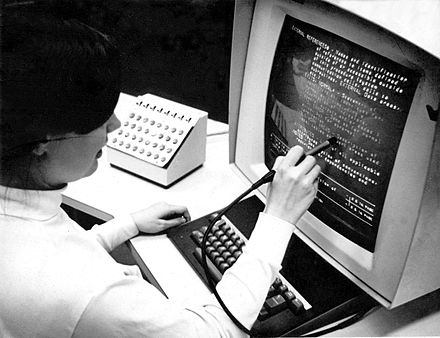
You might think of eBooks as a 21st-century phenomenon, but we can actually trace its history back to the early 20th century. Let’s take a quick look at the brief history of eBooks.
The Birth of the eBook Concept
The concept of eBooks started several decades ago. You might be surprised to learn that the eBook concept predates the publication of America’s first mass market paperback, Pearl S. Buck’s 1938 The Good Earth.
Years earlier, Robert (Bob) Brown wrote his 1930 book, The Readies, in which he imagined an electronic reading machine that would allow people to access and read novels at incredible speeds. Moreover, Brown explained that this invention was portable and would “allow readers to adjust the type size and avoid paper cuts.”
Brown devised this idea after watching his first “talkie” (a film with sound). He reasoned that, with movie technology advancing so quickly, written books needed to catch up with the times.
Brown’s reading machine would allow him to read entire novels in just a few minutes. To achieve this goal, he explained a number of speed-reading ideas to help readers consume text more quickly, hoping to inspire an invention that would help him keep up with his ever-growing reading list.
Of course, we never achieved his speed-reading ideas, but we would eventually accomplish the goal of reading books electronically a few decades later.
Because of his imaginative idea, Brown is sometimes referred to as the “godfather of the e-reader.” Fittingly, you can now access a Kindle edition of Brown’s The Readies. You can also find a simulation of his speed-reading mechanisms online.
A Debate Over the True Inventor of eBooks
It’s unclear who invented the first eBook, but most historians point to Roberto Busa, Ángela Ruiz Robles, Douglas Engelbart and Andries van Dam, and Michael S. Hart as notable candidates.
Roberto Busa
Roberto Busa began working on his 30-year project, Index Thomisticus, in 1946. The project was a thoroughly annotated electronic index of the works of St. Thomas Aquinas that was stored on a single computer. Busa created this invention to help scholars perform text searches within all of Aquinas’s works. Later, in 1989, he created a distributable CD-ROM version of his index to increase its accessibility. Although the Index Thomisticus involved electronic reading, some argue it is not a proper eBook because it is a collection of texts meant for studying, rather than a specific book meant for reading.

Ángela Ruiz Robles
Robles, a teacher from Spain, created a prototype of Enciclopedia Mecánica (Mechanical Encyclopedia), a machine that kept text and images on spools that loaded onto rotating spindles. With this machine, Robles hoped to decrease the number of books her students had to carry. She never produced and sold the device, but she did receive a patent for her invention in 1949. Although her invention accomplishes some of the eBook goals, it’s worth noting that her prototype is mechanical, not electronic.

Douglas Engelbart and Andries van Dam
In the early 1960s, Douglas Engelbart headed the NLS (“oN-Line System,” a computer collaboration system) project at Stanford Research Institute while Andries van Dam led the Hypertext Editing System and the File Retrieval and Editing System projects at Brown University. This new technology made the eBook concept a real possibility, and it allowed Brown University faculty to read primary texts online in the late 20th century. Van Dam most likely coined the term “electronic book,” which appeared in his 1985 article, “Reading and Writing the Electronic Book.”

Michael S. Hart
Many historians credit Hart as the true inventor of the eBook, a student at University of Illinois who earned a degree in Human-Machine Interfaces. In 1971, he planned to send a bunch of folks an email with the United States Declaration of Independence to honor the Fourth of July, but he was not able to transmit all of this information without crashing the email system. Instead, he decided to create an electronic copy of the Declaration with plain text so that his document was very easy to download and view on other devices. Many cite this text document as the first eBook ever created.

The eBook Meets the Internet
After Michael S. Hart discovered a workaround for disseminating an electronic copy of the U.S. Declaration of Independence, he went on to found Project Gutenberg, the oldest digital library in existence. When Hart first began this project, he used ARPAnet (the precursor to modern-day internet). Today, Project Gutenberg uses the power of the internet to provide a free collection of over 60,000 eBooks in the public domain that you can download on any device.
The Creation of eBook Hardware
In 1992, Franco Crugnola Varese and his wife Isabella conceptualized and created the first e-reader, named Incipit, for a thesis project at the Polytechnic University of Milan. Starting in the late 1990s, consumers began to see a number of portable e-reader gadgets for sale, including Rocket eBook, Cybook, and Palm Pilot. The idea of being able to read electronic books on portable devices, instead of a bulky computer, was exciting—but these early gadgets weren’t easy to use. On top of this, eBook copies were extremely limited in the 1990s. (It wasn’t until 1999 that Simon & Schuster became the first trade publisher to simultaneously publish eBook and print format.)
In 2006, Sony launched its Sony Reader, which featured a paper-like screen and an online store where readers could easily find and purchase eBooks. The Sony Reader still required a level of technical savvy, but it was easier to navigate than its predecessors.
It wasn’t until Amazon released the Kindle e-reader a year later that eBook hardware really took off. In fact, customers were so excited about this product that Amazon sold out of Kindles in less than 6 hours, and the device was out of stock for five months.
Apps Increase Readers’ Access to eBooks
2007 was an important year in the eBook’s short history. It brought the launch of the iPhone by Apple, with its application abilities. A couple years later, Sony brought libraries into the e-reading experience through the OverDrive app, which allows patrons to temporarily download eBooks from their local library.
While many modern readers opt for eBook devices like Amazon’s Kindle or Barnes & Noble’s Nook, many companies now offer apps that house eBooks and can be used on a number of devices, such as smartphones, iPads, tablets, and computers. Because you no longer have to purchase hardware to download eBooks, reading online is a lot more accessible nowadays.
A Successful Spike in eBook Sales
Throughout the year 2001, more and more publishers began launching eBook imprints, including HarperCollins, Random House (UK), and Penguin, among others. However, it took quite some time until eBooks really took off. Almost a decade later, Apple released its first iPad, with an iBooks app that sold half a million eBooks in under thirty days. In 2010, Amazon’s eBook sales outnumbered its hardcover book sales for the first time. The following year, Amazon’s eBook sales surpassed its paperback book sales. By 2012, United States eBook sales garnered three-billion dollars in revenue.
EBook success is far from continual or steady. Following the spike in sales during the early 2010s, we saw a fairly steep decline in the U.S. eBook market. In 2016, eBook sales dropped nearly 17%—which is perhaps related to the concurrent widespread increase in average eBook prices from $6 a title to nearly $10.
The eBook in the Face of the COVID-19 Pandemic
Stay-at-home orders and COVID-19 safety precautions are changing the way some of us access books. Kobo, a company that sells both eBooks and audiobooks, revealed that eBook consumption rose 60% between March 2019 and March 2020, and rose 30% more from March 2020 to April 2020. Niti Kumar of Penguin Random House noted that the eBook sales of some genres more than doubled during the first few months of quarantining.
OverDrive, which supplies 90% of North American libraries with eBooks, noted that eBook loans increased 53% during the summer of 2020. Young readers seem to be contributing to this statistic the most, with a 122% jump in young adult nonfiction loans and a 93% jump in juvenile fiction loans.
Although eBook popularity has fluctuated throughout the years, sales suggest that many readers are currently taking advantage of this reading format for knowledge, entertainment, and enjoyment during the turbulent times of the pandemic.

Leave A Comment